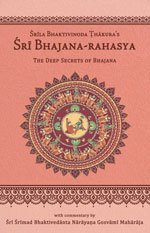Bhajana-Rahasya
by Srila Bhaktivinoda Thakura Mahasaya | 2010 | 123,965 words
The Bhajana-rahasya Text 21, English translation, including commentary (vritti). The Bhajana-rahasya is a compilation of verses describing the mercy of the eight pairs of names (Yugala-nama) of the Maha-mantra. This is text 21 belonging to the chapter “Ashtama-yama-sadhana (Ratri-lila–prema-bhajana sambhoga)” representing from midnight to three-and-a-half praharas of the night: approximately 00.00 a.m.–3.30 a.m.
Text 21
Pride in one’s service is described in these words of Śrīla Raghunātha dāsa Gosvāmī from Śrī Sva-saṅkalpa-prakāśa-stotra (2):
नवं दिव्यं काव्यं स्वकृतम् अतुलं नाटक-कुलं प्रहेली-गूढार्थाः सखि रुचिर-वीणा-ध्वनि-गतिः
कदा स्नेहोल्लासैर् ललित-ललिता-प्रेरण-बलात् सलज्जं गान्धर्वा स-रसम्-असकृच् छिक्षयति माम्navaṃ divyaṃ kāvyaṃ svakṛtam atulaṃ nāṭaka-kulaṃ prahelī-gūḍhārthāḥ sakhi rucira-vīṇā-dhvani-gatiḥ
kadā snehollāsair lalita-lalitā-preraṇa-balāt salajjaṃ gāndharvā sa-rasam-asakṛc chikṣayati māmAho! When, in a secluded place, will I receive such fortune that Śrīmatī Rādhikā will, upon the request of Śrīmatī Lalitā-devī, affectionately and happily–yet shyly–teach me dramas composed by Herself, new poems, riddles with deep meanings, and melodies on the vīṇā ?
स्वकृत-नाटक आर नव्य काव्य-तति
गूढार्थ-प्रहेली, दिव्य वीणा-रव-गतिsvakṛta-nāṭaka āra navya kāvya-tati
gūḍhārtha-prahelī, divya vīṇā-rava-gatiललितार अनुरोधे स्नेहोल्लासे कबे
सलज्ज गान्धर्वा मोरे निभृते शिखाबेlalitāra anurodhe snehollāse kabe
salajja gāndharvā more nibhṛte śikhābe
Commentary: Bhajana-rahasya-vṛtti:
Śrī Gaurasundara entrusted Śrīla Dāsa Gosvāmī to Śrīla Svarūpa Dāmodara. In vraja-līlā Śrī Svarūpa Dāmodara is Lalitā Sakhī. Under her guidance, Śrī Rādhā’s pālya-dāsīs learn how to serve the Divine Couple, and ultimately are blessed with the good fortune of attending Them directly. Śrīman Mahāprabhu is absorbed in the mood of Śrī Rādhā. Here Śrī Dāsa Gosvāmī, harbouring the desire to serve Śrīman Mahāprabhu in his heart, is begging the foot-dust of Śrī Rūpa Gosvāmī to fulfil his cherished yearnings. He wants to attain expertise in all varieties of fine arts that are useful for sevā.
In order to engage Śrī Rati Mañjarī in sevā to Śrī Rādhā’s lotus feet, Lalitā Sakhī took her by the hand to Śrī Rādhā and made the following request: “O Rādhā, this incomparably charming and beautiful girl is very qualified to serve Your lotus feet.” Hearing this, Rādhā, feeling somewhat shy, spoke sweetly to Rati Mañjarī and embraced her to Her heart, moistening her with tears of compassion. Overwhelmed with great affection and urged by the most charming Lalitā Sakhī, Gāndharvikā Śrī Rādhā instructed Rati Mañjarī on poetry, playing the vīṇā, drama, composing riddles and other arts. Śrī Rādhā is completely controlled by Lalitā Sakhī.
Vṛndāvana is the only subject matter of the new transcendental poetry that Śrī Rādhā teaches Rati Mañjarī. The nāyaka in this poetry is Vrajendra-nandana Śyāmasundara and the nāyikās are the vrajadevīs, the embodiments of mahābhāva. In this transcendental f low of rasa there ripples an unbroken stream of waves. The movement of these waves is unrestricted and has an ever-increasing freshness.
As well as teaching poetry, Śrī Rādhā also teaches the art of acting in dramas and the art of composing riddles with deep meanings. The pālya-dāsīs employ this training to stimulate śṛṅgāra-rasa in Śrī Rādhā-Mukunda. The sakhīs ask Śrī Kṛṣṇa, “O best among clever persons, what is young (bāla ) and old, both bound and liberated, and pure but also in darkness?” Perplexed, Śrī Kṛṣṇa begins to think. After some time, He laughs loudly and says, “Śrī Kiśorī’s hair (bāla )!” at which point the sakhīs burst out laughing. The sakhīs please Śrī Kṛṣṇa with such riddles during rāsa-vilāsa, while roaming in the forest (vana-vihāra) and at other times. Śrī Rādhā, who is skilled in all arts, inspires Her sakhīs to please Kṛṣṇa in this way. Furthermore, when they play the captivating vīṇā, having learned the art from Śrī Rādhā, Śyāmasundara’s heartstrings resound.
The ācāryas give the following conclusion for sādhakas: attachment (āsakti), eagerness (utkaṇṭhā) and service filled with the relish of prema-rasa are attained by associating with rasikabhaktas. In Prema-bhakti-candrikā Śrīla Narottama dāsa Ṭhākura says: “rasika-bhakta-saṅge, rahiba pirīti raṅge, vraja-pure vasati kariyā–one attains one’s cherished desire by associating with and serving rasika-bhaktas, and by taking shelter of the land of Vraja.”
